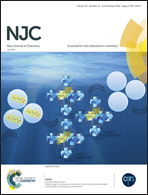The regulation of hydroboration of olefins by oriented external electric field†
Abstract
By employing an oriented external electric field as a catalyst or inhibitor, the model reactions of the hydroboration of terminal olefins with the simplest borane were studied for the first time. The electric fields used in this work are oriented in directions parallel and perpendicular to the C![[double bond, length as m-dash]](https://www.rsc.org/images/entities/char_e001.gif) C bond in the olefins to explore their influence on regioselectivity and barrier height. It was exciting that the first hydroboration of ethylene in an electric field along the parallel direction perfectly proved the relationship between the positively polarized carbon atom on the C
C bond in the olefins to explore their influence on regioselectivity and barrier height. It was exciting that the first hydroboration of ethylene in an electric field along the parallel direction perfectly proved the relationship between the positively polarized carbon atom on the C![[double bond, length as m-dash]](https://www.rsc.org/images/entities/char_e001.gif) C bond and the regioselectivity of this reaction. A very significant finding is that the dominant Markovnikov hydroboration of propene occurred when the external electric field was along its flipped direction. And the kinetic calculations showed that this extent of Markovnikov hydroboration would give an obvious advantage with rising fields, because the ratio kAM : kM had decreased to 0.36 when the field was up to −70 (×10−4) a.u. Additionally, all of the hydroborations of olefins (whether of ethylene or propene) with borane just changed their barrier heights instead of their regioselectivity when the external electric field was oriented in the direction perpendicular to the C
C bond and the regioselectivity of this reaction. A very significant finding is that the dominant Markovnikov hydroboration of propene occurred when the external electric field was along its flipped direction. And the kinetic calculations showed that this extent of Markovnikov hydroboration would give an obvious advantage with rising fields, because the ratio kAM : kM had decreased to 0.36 when the field was up to −70 (×10−4) a.u. Additionally, all of the hydroborations of olefins (whether of ethylene or propene) with borane just changed their barrier heights instead of their regioselectivity when the external electric field was oriented in the direction perpendicular to the C![[double bond, length as m-dash]](https://www.rsc.org/images/entities/char_e001.gif) C bond. The model reaction in this work is meaningful for exploring more complicated hydroboration reactions of olefins experimentally.
C bond. The model reaction in this work is meaningful for exploring more complicated hydroboration reactions of olefins experimentally.



 Please wait while we load your content...
Please wait while we load your content...